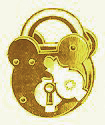|
4. The Work Force
Many
complained that the pay was low; but it was regular and better
skills bought better pay. The record of just how many put in year
after year of service, the job satisfaction speaks for itself. A man
who had nothing to thank his factory for would most certainly not
recommend to his
offspring that they should find employment where he worked.
That the Gibbons factory had sons, fathers and grandfathers
working at the same place at the same time did show that the old
adage of "if you know a better hole, go to it" was well in
mind.
With
so many faces and individuals in memory, before continuing about who
they were and what they did at Gibbons as a family of workers, while
one’s memory flicks from one thing to another, there is a part of
Gibbons history, which though not of great importance to some was,
at the time, of great
importance to the work people involved.
In the factory records was a sheet of paper about 9 inches
square. It was a
"Round Robin", made up of names in a circle radiating like
the spokes of a wheel so that, unlike a list, no name appeared on
the top to suggest who was first to put his name to the complaint
and thereby invite retribution as the ringleader.

The round robin |
The text reads: "We the undersigned
men in your employment feel very much dissatisfied as
regards Mr. Brassington your clerk. Our grievance,
firstly, we can scarcely ever find him sober and at times
hardly able to settle our accounts as regards our reconing
(sic) our work Secondly we aks nothing but what
is fair and just to put us our work down and to state what
money we are going to receive in the morning and not to have
it altered at night for it makes things very
unpleasant. We wish to have our work put down in ink
not like it is now in black lead. Thirdly we hope that
you will have the kindness to recon (sic) with us for the
future. For we do not intend to go to settle with Mr.
Bassington any more. Yours resy your workmen". |
In
those earlier days, the factories had a "Works Foreman"
who could hire and fire on behalf of the boss. Like a regimental
sergeant major he patrolled the factory to keep order and see that
no one slacked on the job. An important part of his duties was to
hand out the pay to his charges on Friday night or Saturday.
He would know who had done what and how much was due to
individuals. Having
paid out there would sometimes
be a little left, which went into his pocket.
It would appear that one such gentleman had long pockets as
some of the workers found out when they felt that they had been
diddled. Thus it was that the Round Robin was sent to the owner of
the factory, the old Mr James Gibbons, imploring him to do something
about the erring foreman. What
happened about this complaint is unrecorded but this wonderful part
of factory history sticks in the mind of one who held it and read it
before it was lost forever in clear-outs that followed the
takeovers.
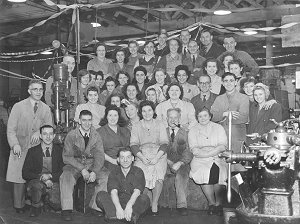 |
Staff of the Machine
Shop, 1948. |
Examples
of the pride that the workers had in what they produced could
sometimes be seen when away from the workbench.
The little chap whose job was to assemble "penny door
locks" for municipal toilets would, when on his week’s
holiday at the seaside, try every door lock in a row to see that
they were working alright, carrying a store of pennies for the sole
purpose. He would
despair at having to dismantle some, to remove washers or buttons
that had jammed the mechanism, so that these door locks stood
between the discomfort and comfort of anyone with a problem whether
a big one or the even bigger one of no small change.
| A Sales Conference -
company directors and the sales force met at the Sports and
Social Club. |
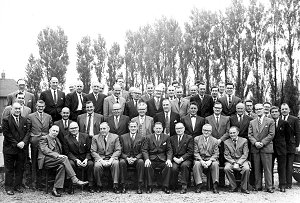
|
Back to a few individuals who come to memory.
Jack
Wharton, the supervisor of the Spring Door Shop, would occasionally
be seen pushing a plate glass door wide open just to see it return
to the closed position, calculating how long it took. Like so many others he was described as a "Gibbons
man", one who would have the good name of the firm in his mind
at all times. Later a
new product of skinning over aluminium with stainless steel sheet
for shop fronts and offices was added to his responsibilities.
For this he had to learn to drive so he could get to
customers. This, at a late stage in his employment, caused him some
apprehension but he managed it, after much practice on the works car
park on Saturday afternoons and Sundays.
James
Gibbons fame in the industry of lock making owes much to one family
in particular: the Robbins family.
I do remember Arthur Robbins Senior and his son Arthur
Robbins Junior. This family descended from other older members of
the family of three generations of locksmiths, whose skilled
expertise will still be found in locks across the country.
Young Arthur possessed a lock with a tiny key.
Made from two threepenny silver bits, it worked like a watch
smaller than a small thumb nail.
It could well be that the photograph that appears in old
catalogues of a lock maker at his bench is one of the famous Robbins
family. He may
have started at the age of twelve in the workplace, as this was
normal at that time until the school leaving
age rose to fourteen.
Ike
Timmins was the foreman of the plating shop and in charge of the
"bronzing" of brass work.
Bronzing changed the appearance of polished brass to look
like bronze. A chemical powder was mixed with ammonia to a thin paste,
painted on to the highly polished brass and allowed to dry.
Long hand brushes were then used to buff the object, which
would then have the appearance of solid bronze.
The stained brass retained its colour by polishing only with
furniture wax. A
kindly, religious man, Ike
was of the working gentleman school, who never swore or cursed -
though if really pushed his description was: a
"thundering" thing. One of his achievements in his plating trade was to produce a
"matt" (satin) plating that looked like silver and never
needed polishing. The
only pair of Gibbons candlesticks that ever received this treatment
stand on my mantleshelf, a tribute to his skill and valued
friendship.
Vic
Shermel, a small, rotund man, was the engraver of decorative
figures, door handles, plates etc.
An artist in metal, his different hammers and chisels worked
on the dressings after casting in brass and bronze. Sometimes he
worked by oil lamp to ease his eyes from constant attentive looking
at small work engraving, expensive lock plates and door knobs.
The designs for these would have been drawn up by an
architect, knowing that the Gibbons work force would do justice to
them.
Sir
Gilbert Scott and Sir Christopher Wren are remembered by the
buildings and their contents but little thought is given to the
lower end of the exercise, those who worked and produced or built
them. Much of the
skills of such men as Vic Shermel have been lost forever with
progress and the need to produce cheaper and quicker builders’
requirements and hardware; when wages were low, time could be
allowed for beauty and perfection
but that is not the case today.
Gibbons
had a strong ladies work force at Church Lane.
They came during the war and carried on at the lathe or drill
afterwards, accepted as equal if not paid the same rate of pay -
that came later in British factories.
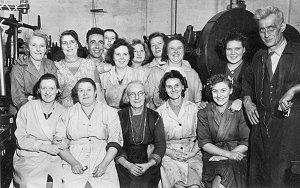 |
Ladies and Gentlemen of
the Press Shop. |
Quite
a few of these ladies worked in the Machine Shop.
The Setter Up was a man named Albert Lycett. Albert would look after the lathes and drillers operatives,
mainly women, who were not averse to giving him the blame if the now
old lathes started to play up after years of war work.
As nice a man as one could meet, Albert married one of his
flock, "Vicky", then on retirement lived in Milton Road,
Fallings Park. He was a member
of the Rifle Club and helped to dismantle a former hospital ward at
RAF Bridgnorth, which was transported by the firm’s lorries and
erected at the Sports Club on the Birmingham New Road. A popular and
lovely couple who had a good word for everyone, now long gone but
remembered with affection.
After
the second world war former workers returned to the factory after
demobilisation. One who hadn’t work at Gibbons however, was a
former RAF stalwart. Sgt.
Stan Lane was the commissionaire.
Many an R.A.F. "sprog" (or recruit) would remember
Stan Lane. He was the
Station Provost Sgt. at R.A.F. Cosford during the war, though having
joined the RAF as a boy saw service in the desert of Arabia with a
Rolls Royce Armoured Car section.
When war broke out he was on Fighter Stations during the
Battle of Britain and was then posted to Wolverhampton’s RAF
Cosford. His first job
after demob was as commissionaire at Beattie’s shop in
Wolverhampton. He was
poached and his domain was the Time Office next to the main offices.
Until retirement he lived in a part of Ruckley Grange. This was owned by Mr Harry Attwood, the agent for the Rolls
Royce and Bentley cars. His
garage was at the top of Stafford Street.
In his job Stan was a typical service type of the old school,
firm but fair. Old
employees visiting the factory he tolerated up to a point,
but too many visits and you had to meet your former workmates
in the street outside after hours.
Just a little thing of the memory of Sgt. Lane, was his
boots. Rain or snow,
they had a shine like mirrors. One could imagine a recruit standing in front of them,
hypnotised and wondering what his fate would be for catching the eye
of the Provost Sergeant. But
his bite was by far worse than
his bark.
The
assistant in the Time Office was Sam Challenor. One could never forget Sam, a sense of humour with a store of
jokes, and stories that beggared belief.
A Bilstonian, he was as proud of his roots as a landed lord,
never ashamed of his accent though at times he emphasised it a
little. In charge of
the time office teapot, his dulcet tones could be heard half way
round the factory, "Tays med, ‘tis med"
What a character! He
did not fully appreciate the large influx of new arrivals coming
into the country at that time, before such opinions were suppressed
by law on the fear of death.
Sam had served as a soldier and he fully thought that he had
earned the right of free speech and gave full vent to it. On
retirement Sam became chairman of an Old Folks Club along the
Birmingham Road and was sadly missed on his death, for his
dedication to others as well as his family of "Challenors".
Simon
Perry came to Gibbons from the firm of Cyrus Price the safemakers.
The story of
this most honest and remarkable man has been told in the Black
Country Bugle by the man who had the job of taking him round the
country by car to open safes. He was a master "Cracksman"
whom it is known, from the records that were in the
firm’s offices, had never been beaten when opening a safe.
His forte was that after he had opened an offending safe he could
leave it just as secure afterwards, without destroying it with the
"cracking" open procedure of drilling around the lock.
| New people joined all
the time and mostly they stayed. Here is the first
intake of apprentices. |
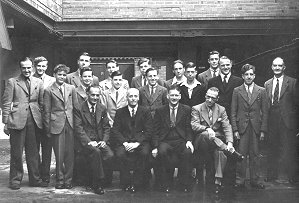
|
So
many names, so many products that would take volumes to write about
and do justice to these people, what they made and how they lived,
their joys and sorrows that would
see a hat passed round to help in situations that
arose again and again. A wedding, a birth, a retirement a
death, people giving what they could in the days when hand outs from
the Government were far from the norm that it is today, for anyone
albeit having been in the country but a few days. That small
contribution was received gladly from workmates who knew from
experience that the little extra was oh so well needed.
On
another page (linked at the bottom of this page) there are
photographs of as many other members of the staff who were there in
my time as I could find photos of. All of them, and all those
not mentioned here, deserve to be remembered as individuals and as
members of a great team.
|
